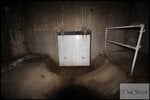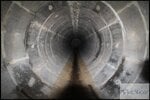If you will pardon the pun then it is with great relief to have finally traversed the full length of this drain after first climbing down the ladders seven years ago.
During this protracted period, I have probably paid around ten visits to the drain and on my first trip, was accompanied by my brother who doesn’t normally do this kind of thing but was persuaded to give it a go. Strangely enough, he has not been in a drain since! I can only think that walking down a smelly slippery pipe from Shoreditch to Highbury then climbing a 100 foot ladder back up to street level wasn’t his cup of tea. However following that memorable visit, I have returned on separate occasions with ConcreteJungle, Ojay and tallginge (in that order).
Taking seven years to see this drain from beginning to end is a slightly odd and philosophical experience. During this time I lost my job, a grandmother and an uncle yet gained a beautiful daughter who is already in her second year at school. As a result, the various sections of this drain casually remind me of these milestones in life.
Anyhow, enough of my waffling, below are the photos in order of upstream to downstream:
Deep Ochre begins at the bottom of a dropshaft at an overflow chamber on the Northern High Level Sewer in North Highbury. As you can see, a couple of smaller egg shaped local sewers add their feculence to the filthy torrent.
Accessing this chamber is not as simple as just dropping in from the street above and instead entails climbing a heavily wet wipe, jamrag and bog roll encrusted ladder before clambering on hands and knees over more of said filth hanging from a grille to then squeeze into the CSO chamber.
From here it is a 1km stoop south along this 5ft diameter blue and yellow brick tunnel.
Eventually the stooping is over and Deep Ochre intersects the 7ft diameter Holloway Storm Relief at what is known as the Orly Junction.
We could now finally stand up straight and let our poor backs recover while admiring what is one of my favourite parts of the London Main Drainage system.
Orly really is an orgy of red, yellow and blue brick, curves, slopes and steps. Victorian Civil Engineering at its finest.
There really shouldn’t be any flow except during periods of rainfall or excessive discharge of wastewater to the sewer but for the last few years there has been a constant and often significant quantity of overflow entering this junction from the Holloway Storm Relief Sewer to the west which in turn has received this from Northern High Level Sewer further upstream.
From the Orly junction downstream (approx. 4.5km), the tunnel is 8ft in diameter and features little in the way of any interesting features(not photographed) except for an immensely slippery fibreglass section under what I suspect is a railway line and also a dropshaft to allow overflow from the Middle Level Sewer #2.
In Bethnal Green, The tunnel expands in diameter to a huge 12ft at the point where the Middle Level Sewer #1 passes above. Here there is a large overflow chamber with a nice staircase for the flow to cascade under storm conditions.
A hundred metres or so further downstream, a 4ft tunnel with crystal clear water running from it (not photographed) joins from the east which according to the map, eventually leads back up to the Holloway Storm Relief west of Dalston. Unfortunately, this section of Deep Ochre is one of the sections which is presently spoilt by a series of dams which were put in as part of the ongoing Crossrail project that causes the water level to back up and fester in a foul putrid manner.
The next six pics were taken by Tallginge, the first shows me trying not to breach my waders in the filthy stagnant water behind one of the dams.
The Crossrail Act 2008, Work No. 1/26C states that “A diversion of the North Eastern Storm Relief Sewer, commencing by a junction with that sewer beneath a point 112 metres west of the junction of Durward Street with Brady Street and terminating by a junction with that sewer beneath a point 100 metres south-west of the junction of Durward Street with Brady Street. Work No. 1/26C includes a shaft for construction and maintenance”.
A little further south below Whitechapel Station, the evidence of this work can be seen, although I would not describe the sewer to have been diverted. Instead following the final dam which is fitted with a connection for a pipe to be attached so that the ‘water’ can be pumped above ground while the work was in progress, the tunnel has been concrete lined and has had a large shaft built above it with lots of cables leading to sensors of some kind attached to the walls.
There were also a number of ‘cats eyes’ type devices that presumably were there to check for disturbance to the drain whilst the Crossrail tunnel was being bored.






